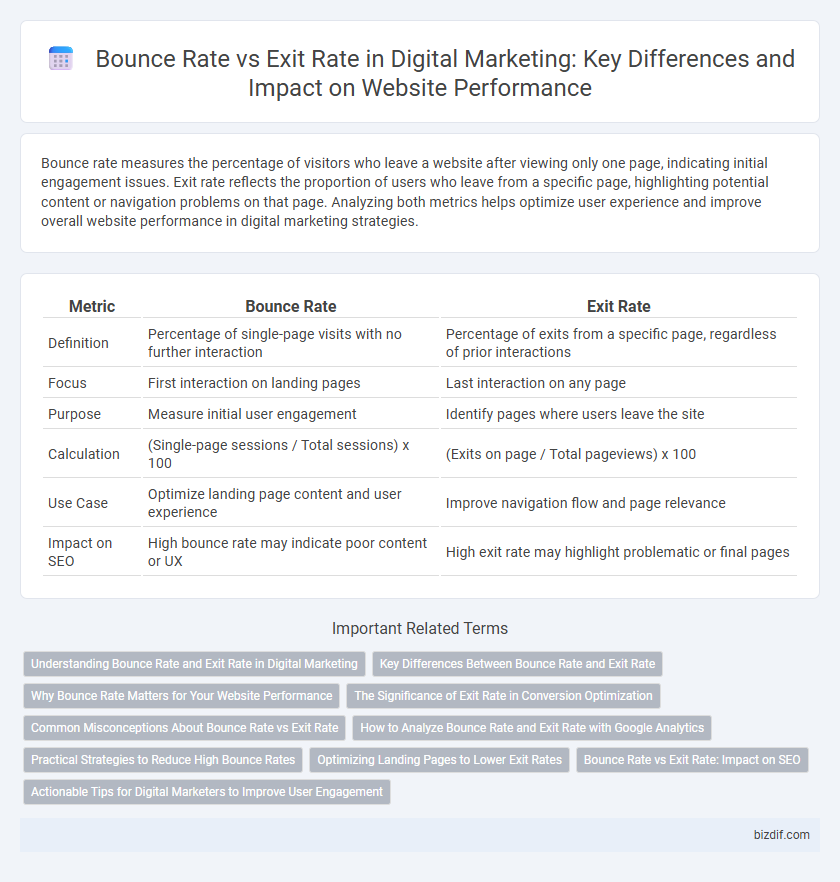Bounce rate measures the percentage of visitors who leave a website after viewing only one page, indicating initial engagement issues. Exit rate reflects the proportion of users who leave from a specific page, highlighting potential content or navigation problems on that page. Analyzing both metrics helps optimize user experience and improve overall website performance in digital marketing strategies.
Table of Comparison
| Metric | Bounce Rate | Exit Rate |
|---|---|---|
| Definition | Percentage of single-page visits with no further interaction | Percentage of exits from a specific page, regardless of prior interactions |
| Focus | First interaction on landing pages | Last interaction on any page |
| Purpose | Measure initial user engagement | Identify pages where users leave the site |
| Calculation | (Single-page sessions / Total sessions) x 100 | (Exits on page / Total pageviews) x 100 |
| Use Case | Optimize landing page content and user experience | Improve navigation flow and page relevance |
| Impact on SEO | High bounce rate may indicate poor content or UX | High exit rate may highlight problematic or final pages |
Understanding Bounce Rate and Exit Rate in Digital Marketing
Bounce rate measures the percentage of visitors who land on a single page and leave without interacting further, indicating the effectiveness of landing pages in capturing immediate interest. Exit rate represents the proportion of users who leave the site from a specific page, reflecting the page's role in user navigation and potential drop-off points. Analyzing both metrics helps digital marketers optimize user engagement, improve content relevance, and enhance conversion pathways.
Key Differences Between Bounce Rate and Exit Rate
Bounce rate measures the percentage of visitors who leave a website after viewing only one page, indicating a lack of engagement or relevance on entry. Exit rate calculates the percentage of users who exit from a specific page, reflecting its role in the user journey regardless of the number of pages viewed. Understanding these metrics helps optimize user flow and improve content effectiveness by identifying entry page issues (bounce rate) versus exit page significance (exit rate).
Why Bounce Rate Matters for Your Website Performance
Bounce rate measures the percentage of visitors who leave your website after viewing only one page, indicating potential issues with content relevance, user experience, or site speed. A high bounce rate can signal that your landing pages are not engaging or aligned with visitor intent, leading to lost conversion opportunities and reduced search engine rankings. Optimizing bounce rate through targeted content, faster load times, and clear calls-to-action improves user retention, enhances overall website performance, and drives higher ROI in digital marketing campaigns.
The Significance of Exit Rate in Conversion Optimization
Exit rate reveals the percentage of visitors leaving a specific page, providing insights into potential bottlenecks in the conversion funnel. Unlike bounce rate, which measures single-page sessions, exit rate highlights pages that may require optimization to keep users engaged and guide them toward conversion goals. Analyzing exit rate helps identify underperforming content or technical issues that could be hindering overall conversion rates.
Common Misconceptions About Bounce Rate vs Exit Rate
Many marketers mistakenly equate bounce rate with exit rate, assuming both metrics indicate the same user behavior. Bounce rate measures the percentage of single-page sessions where visitors leave without interacting further, while exit rate reflects the proportion of users leaving from a specific page after possibly visiting multiple pages. Understanding the distinct definitions is crucial for accurately analyzing website performance and optimizing user engagement strategies.
How to Analyze Bounce Rate and Exit Rate with Google Analytics
Analyzing bounce rate and exit rate in Google Analytics involves examining user behavior to identify pages that fail to engage visitors or lead to conversions. Bounce rate measures the percentage of single-page sessions where users leave without interaction, while exit rate indicates the proportion of users leaving after visiting a specific page. Utilizing Google Analytics reports like Behavior > Site Content and creating segments helps pinpoint high bounce and exit rates, enabling targeted optimization strategies for improving user engagement and conversion rates.
Practical Strategies to Reduce High Bounce Rates
High bounce rates often indicate that visitors do not find the landing page content relevant or engaging, leading to quick exits without further interaction. Implementing practical strategies such as improving page load speed, enhancing user experience with clear call-to-actions, and optimizing content relevance to targeted keywords significantly reduces bounce rates. Monitoring user behavior with analytics tools enables continuous adaptation of landing pages to match visitor intent and decrease bounce frequency effectively.
Optimizing Landing Pages to Lower Exit Rates
Optimizing landing pages to lower exit rates involves improving page load speed, making calls-to-action clear and compelling, and ensuring content relevance to user intent. A high exit rate indicates users leave from that specific page, signaling a need for better engagement or navigation options. Reducing exit rates enhances user retention and increases the likelihood of conversion, directly impacting overall digital marketing performance.
Bounce Rate vs Exit Rate: Impact on SEO
Bounce rate measures the percentage of visitors who leave a website after viewing only one page, while exit rate indicates the percentage of exits from a specific page regardless of the number of pages viewed. High bounce rates can negatively impact SEO by signaling poor user engagement or irrelevant content to search engines, reducing rankings. Exit rates help identify pages where users commonly drop off, enabling targeted improvements that enhance user experience and indirectly support better SEO performance.
Actionable Tips for Digital Marketers to Improve User Engagement
Lowering bounce rate and exit rate requires targeted strategies such as improving page load speed, refining content relevance, and optimizing calls-to-action to keep users engaged. Implement heatmaps and user behavior analytics to identify drop-off points and tailor site navigation for seamless user experiences. Regularly testing landing pages and personalizing content based on visitor segments significantly boosts user retention and interaction metrics.
Bounce rate vs Exit rate Infographic

 bizdif.com
bizdif.com